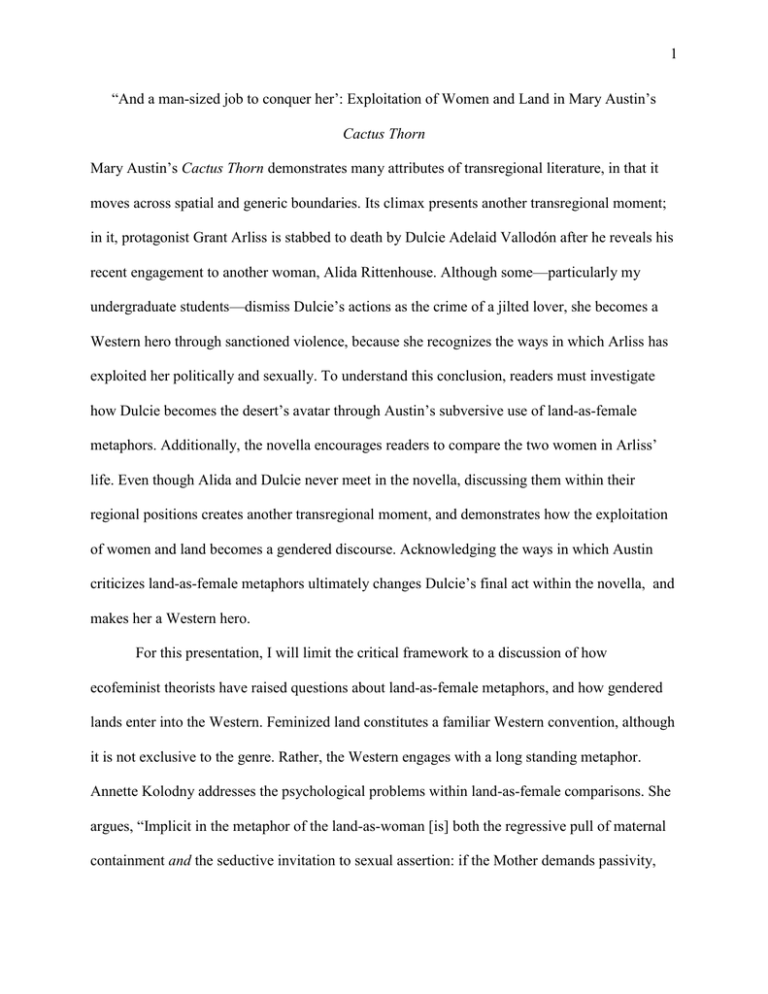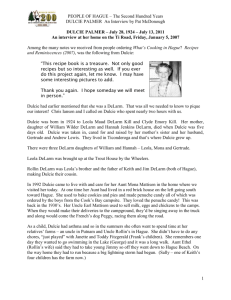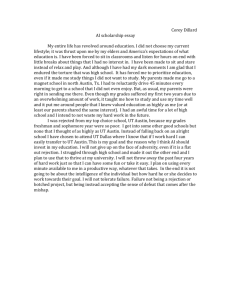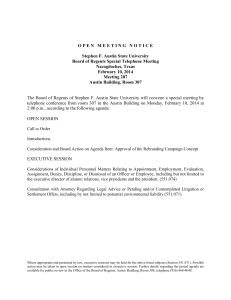
1
“And a man-sized job to conquer her’: Exploitation of Women and Land in Mary Austin’s
Cactus Thorn
Mary Austin’s Cactus Thorn demonstrates many attributes of transregional literature, in that it
moves across spatial and generic boundaries. Its climax presents another transregional moment;
in it, protagonist Grant Arliss is stabbed to death by Dulcie Adelaid Vallodón after he reveals his
recent engagement to another woman, Alida Rittenhouse. Although some—particularly my
undergraduate students—dismiss Dulcie’s actions as the crime of a jilted lover, she becomes a
Western hero through sanctioned violence, because she recognizes the ways in which Arliss has
exploited her politically and sexually. To understand this conclusion, readers must investigate
how Dulcie becomes the desert’s avatar through Austin’s subversive use of land-as-female
metaphors. Additionally, the novella encourages readers to compare the two women in Arliss’
life. Even though Alida and Dulcie never meet in the novella, discussing them within their
regional positions creates another transregional moment, and demonstrates how the exploitation
of women and land becomes a gendered discourse. Acknowledging the ways in which Austin
criticizes land-as-female metaphors ultimately changes Dulcie’s final act within the novella, and
makes her a Western hero.
For this presentation, I will limit the critical framework to a discussion of how
ecofeminist theorists have raised questions about land-as-female metaphors, and how gendered
lands enter into the Western. Feminized land constitutes a familiar Western convention, although
it is not exclusive to the genre. Rather, the Western engages with a long standing metaphor.
Annette Kolodny addresses the psychological problems within land-as-female comparisons. She
argues, “Implicit in the metaphor of the land-as-woman [is] both the regressive pull of maternal
containment and the seductive invitation to sexual assertion: if the Mother demands passivity,
2
and threatens regression, the Virgin apparently invites sexual assertion and awaits impregnation”
(67). Regardless of intentions, Kolodny contends the metaphor simultaneously invites maternal
and sexual desires. Furthermore, Carolyn Merchant tracks how American literature and art have
rendered natural spaces feminine. Nature becomes Eve to the nation’s American Adam.
Merchant notes a few permutations in this metaphor: Eve as virgin land, as fallen land, and as
fruitful garden (117). In each instance, literature, history, and art promote images in which men
need to improve the land. However, these metaphors often become fraught with rhetorical and
ethical problems. Gender politics becomes the most pertinent issue, as these metaphors have
“negative sexual, acquisitive, and exploitative connotations” (Merchant 119). While land-asfemale metaphors may seem innocuous, the above mentioned connotations combine with
“ethical imperatives” and “permissive ideologies” to create stories and myths which implicitly or
explicitly call for the exploitation of land and women (Merchant 124).
Land-as-female metaphors find themselves within cultural promotion of the American
West and the Western genre. Merchant notes, “the idea of an Edenic fruitful, female land—
waiting to be seduced, plowed, planted, and watered by male ingenuity—gripped the
imaginations of settlers and promoters of the American West” (125). Such promotion diminishes
the roles that women played in the colonization project,1 and paves the way for the Western’s
masculinizing myth.2 In removing women from the myth, the western United States becomes the
“West,” a recently colonized space that links conquest and settlement to male bodies and
psyches. In the West, men enter a physical place and metaphysical space in which they can prove
masculine virility. Jane Tompkins designates both the location and work as “expand[ing] [men’s]
meanings, endow[ing] them with an overriding purpose, and fill[ing] them with excitement”
(12). Whether it is a gunfight, breaking broncos, ranching, pocket mining, killing Injuns, etc., the
3
“West” provides tests of virility through dominance. The myth provides a strenuous cure through
re-educating nineteenth-century men how to be manly. In each example, the masculinized West
codifies certain gender expectations and encourages men to act accordingly. It becomes a
nostalgically remembered space of male conquest and healing: it is into this space that Grant
Arliss desires healing.
Mary Austin’s Cactus Thorn evokes the mythic narrative within the Western—the young
man in need of the West’s restorative space—before Austin undercuts it. It provides sex, murder,
and discussions of land, albeit in ways that questions the Western’s use of land-as-female
metaphors. Melody Graulich notes, “[the novella] is daring in its ironic treatment of male
attitudes and its willingness to express a uniquely female way of seeing” (Afterword, 118).
Austin provides this ironic treatment, because she has chosen an unscrupulous male protagonist
whom readers will follow. (As such, I will most likely affect my presentation of Arliss’
thoughts.) Arliss comes West to recuperate and compose his political program. While waiting for
a train to Los Angeles, he meets Dulcie Adelaid Vallódon, and enacts the Western myth.
In Dulcie’s brown body, Arliss identifies his masculine test, because Dulcie represents
the desert and femininity. Arliss’ first observations of Dulcie cannot separate the Western
woman from the surrounding desert. Shortly after arriving in “the naked glare of a land whose
very shadow looked rusted by the sun, he could scarcely take her in, lovely as she was, as a
separate item of the landscape” (Austin, Cactus Thorn 3). The sun’s glare temporarily distracts
his male gaze, but Arliss immediately connects woman to land. He further conflates Dulcie with
the desert, as having “assembled herself from the tawny earth and the hot sand” (Austin, Cactus
Thorn 4). Dulcie’s body becomes an object of desire and fulfillment.
4
Another character, mining engineer and former college mate Fernald, explicitly links the
land to femininity, and articulates why Arliss’ pursuit of Dulcie becomes imperial. In discussing
the land, the miner dismisses the desert’s appeal to woman: the land cannot offer civilization to
the fairer sex. But Fernald sees the land’s appeal to men:
“For me, I’ll take the open country,” Fernald said, looking sideways as men will,
more shy of the spiritual aspects of procreation than of its vulgarities. “’S a great
country,” he said, letting his eyes wander from the high window to round-bosomed
hills and the cradling dip of the land seaward. “A man-size job to conquer her …
make her bear … great civilizations…” (Austin, Cactus Thorn 24)
Fernald’s description of the desert highlights its feminine qualities. The description of “roundbosomed hills” suggests the dual nature of the land being nurturing and sexually alluring. “The
cradling dip” suggests reproductive organs imagined onto the land. But this metaphoric
description excludes an equal balance in the relationship. Men must conquer the land; make the
land bear “great civilizations.” The female land—and by extension women—is silenced and
made an unequal partner.
Arliss’ sexual conquest becomes imperial, because Dulcie is directly tied to the land and its
inhabitants. Although Arliss does not express the same sentiments as Fernald, the narrative
divulges a similar taste in the politician’s thoughts. He expresses displeasure in women who
“wanted something in exchange; they wanted marriage, or they wanted an opportunity to express
themselves in life” (Austin, Cactus Thorn 20). Arliss’ ideal woman provides him with sex and
companionship, but she must remain in the background. Dulcie becomes a sexual object that
Arliss takes. Moreover, the narrative hints that Dulcie’s hereditary background makes her
representative. Dulcie reveals her mother was Southern—meaning that she is of Mexican
5
descent—and her father’s name was Kennedy (Austin, Cactus Thorn 34).3 Her long standing
friendship with Indian George and Catameneda constitute a third important culture to the
southwest; through her relationship with the Paiutes, Dulcie receives an indigenous knowledge
of the desert. Arliss’ handling of the relationship is motivated by his desire for Dulcie without
ramification. She is supposed to remain out west when Arliss returns home.
Arliss’ relationship is imperial on a political level as well, because he directly connects
political passion with sexual companionship. Graulich identifies Arliss’ intentions as satirical
because he believes sex will cure his political impotence.4 Having come to the desert a broken
man, Arliss assumes that “if only he could find a woman who could be counted on to kindle a
flame and keep it going, he might, at that glow, warm the slowly chilling reaches of his intellect
and his ambition” (Austin, Cactus Thorn 13). He uses similar language in discussing his political
career: “What Arliss wanted was to be filled again, to be warmed and quickened, to be raised to
the level of personal competency from which he could again command his own career” (Austin,
Cactus Thorn 19-20). In both quotes, Arliss’ relationship demands a passive role from the
feminine. What she provides, however, conflates maternal and sexual desires: he wants to be
both comfortably warm and intimately quickened. The novella quickly moves from Arliss and
Dulcie’s heavily implied first sexual encounter to Arliss discovering his mind readied to write his
political platform (Austin, Cactus Thorn 53). Furthermore, “Arliss’s western “healing” comes at
the expense of the West” (Graulich, “Walking Off” 274). Arliss lifts his political thought from
Dulcie, “a symbolic mining of the West” (Graulich, “Walking Off” 274). As Dulcie educates
him on indigenous concepts of Medicine and the ecological “laws of the desert,” he in turn
delivers these thoughts as individual rights and “democracy in action.” And so Arliss leaves the
6
West, his political career refueled from his experiences with Dulcie as well as the knowledge he
has grafted from her.
With Dulcie seemingly left in the southwestern desert, Arliss turns his attention to
another woman, Alida Rittenhouse. This move to another woman takes on transregional
qualities, because Alida comes to represent an Eastern political landscape. The daughter of a
powerful senator, she can ensure Arliss’ political career through marriage. Graulich comments
that “Alida is the medium of exchange that binds the two men together, and she will serve Arliss
as she served her father,” from the background (“Walking Off” 277). Arliss will use Alida as he
has used Dulcie, although for different purposes. He has gained an ally in her father: Alida
herself is excused from the political arena. Instead, as Austin writes:
If he married her, and by Thanksgiving time Arliss knew that he was looking
forward to marrying her not only as an excellent thing to do for himself but as an
exquisite and informing experience, she would be a perpetual fire in the presence
of which he would never have any occasion to think of the chemistry or materials
of combustion. (Cactus Thorn, 82)
Again, Arliss reduces a woman to commodities: he will mine her political connections and body
for fuel. Alida will provide him with domestic comforts, sexual completion, and a racially
appropriate marriage. Alida is white. With her provincial ways and brown skin, Dulcie is a
politically conscious outlier that Arliss must silence.
But Arliss’ decision to marry another only informs Dulcie’s actions in the novella’s
ending to a certain extent. Arliss’ vehement dismissal of Dulcie—he calls her a hussy—
demonstrates sexual and political exploitation. When Arliss rejects her, Dulcie comes to
understand their relationship; she declares “‘I was just used—exploited—in the eternal war—the
7
war between men and women’” (Austin, Cactus Thorn 98). Dulcie’s use of “exploited” takes on
layers when readers consider all that Dulcie represents and all that Arliss took from her. Arliss
views the relationship through the cultural lens of masculine dominance. Similar to the land,
Arliss believes he can have the female representative with no commitment. Dulcie, however,
offers a counternarrative that reveals Arliss’ duplicity. Describing her relationship with Arliss,
she says, “I knew it was right for me to have you. I could make you feel things that were not
about me. I could make you feel stronger and clearer about things that had nothing to do with
me. I thought it was right for you to have me, because you could do things with me that you
couldn’t do without” (Austin, Cactus Thorn 73). In her narrative, Dulcie willingly gives herself
to Arliss for a larger purpose. Where other men—including her estranged husband—only feel,
Dulcie grants her body and knowledge to Arliss so he can accomplish a great work. Given the
above passage’s context5 and the novella’s female-as-land metaphor, Dulcie and the desert
become interchangeable in this passage. Dulcie has given Arliss access to the desert—knowledge
about its ecological and cosmological constructs. He may use this knowledge to act. However,
his action is conditional; he must act with Dulcie. This returns to an equal partnership which
Arliss rejects.
Dulcie enacts a revenge for femininity and the land she represents when she murders
Arliss with her dagger. Dulcie justifies the murder, seeing the violence as self-defense. In an
earlier conversation that foreshadows the murder, Dulcie confirms her thoughts. “‘I thought I
could understand that, too, about killing. … It would be self-defense. When people are tortured
more than they can bear,’” she tells Arliss, “‘if I had known what I was doing, he’d have the
right’” (Austin, Cactus Thorn 86). It is self-defense if the perpetrator has caused more damage
than the victim can bear. Arliss’ two-fold guilt encompasses several forms of exploitation. He
8
has used Dulcie for sexual gratification, and has left her to advance his career. Doing so
implicates him with political misconduct. Arliss has appropriated Dulcie’s desert ideology to
promote a political ethics that he does not follow. He presumes that time and distance preclude
him from culpability. He assumes he has control of the situation. Exploited and turned away,
Dulcie murders the exploiter, her action affirming her role as desert avatar. Her mode of murder
is intimate and subversive. Unlike the traditional Western which often ends with a gun battle,
Dulcie uses a dagger—the cactus thorn: this confirms her relationship to her land and its people.
It provides the vengeance which the novella has foreshadowed throughout. She provides balance
with her act, before she returns to heal in the newly purged Western region.
Works Cited
Austin, Mary. Cactus Thorn. Reno: U of Nevada P, 1988. Print.
Kolodny, Annette.
Graulich, Melody. Afterward. Cactus Thorn. By Mary Austin. 1927. Reno: U of Nevada P, 1988.
Print.
---. “Walking Off an Illness? Don’t Go West, Young Man: The Construction of Masculinity in
Cactus Thorn.” Exploring Lost Borders: Critical Essays on Mary Austin. Ed. Melody
Graulich and Elizabeth Klimasmith. Reno: U of Nevada P, 1999. 267-82. Print.
Merchant, Carolyn. Reinventing Eden: The Fate of Nature in Western Culture. New York:
Routledge, 2003. Print.
1
Although they are largely excluded from Westerns, female European settlers often participated in
colonial projects through cultural acclimation. Where men are depicted as engaging in explicit physical
oppression, women engaged in cultural and religious genocide of indigenous people. See Sandy Grande’s
Red Pedagogy.
9
Merchant notices this erasure of women’s presence from the myth when she writes, “The realities of
living in the West belie the Edenic promotions. Women labored on the land and in the home with
backbreaking work as intenxe as that of men” (126).
2
Graulich affirms that “[Dulcie’s] indeterminate but certainly mixed racial background further
embodies the multiracial, multicultural West that Austin so valued” (“Walking Off” 275).
3
4
5
Graulich puns on Kolodny’s work, stating “Arliss has a lay with the land” (“Walking Off” 274).
The passage occurs as Dulcie reveals her relationship to her husband, a fact that she did not
reveal to Arliss. The preceding discussion involves Dulcie relating an experience with her
husband. Coming upon some mountain sheep, Dulcie directs his attention to the herd. Her
husband takes a shot at the sheep “from behind [Dulcie’s] skirt,” suggesting a lack of respect for
the desert. Dulcie’s final thought, “I was never real to him” works within the ambiguity (Austin,
Cactus Thorn 73). The husband’s lack of respect for the land and its creatures extends to his
actions with their human avatar.







